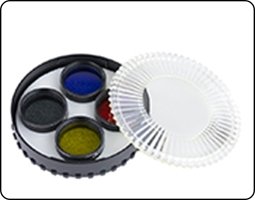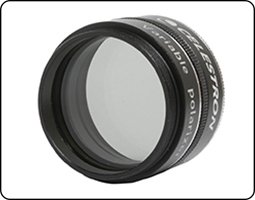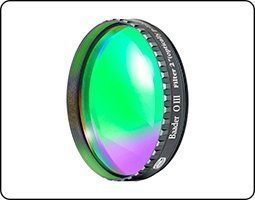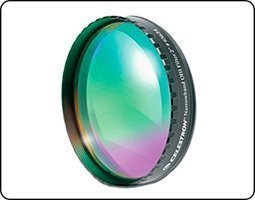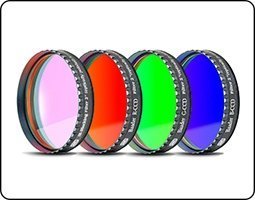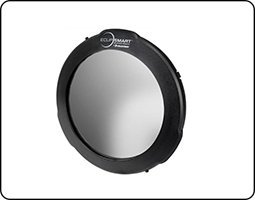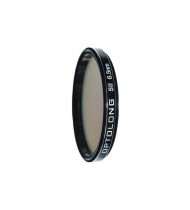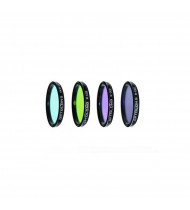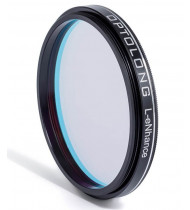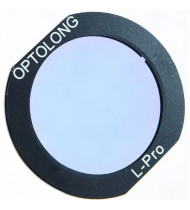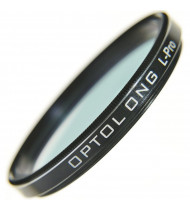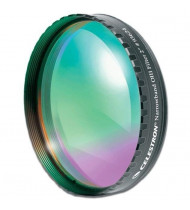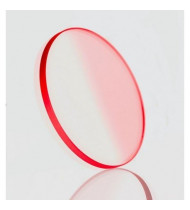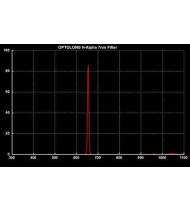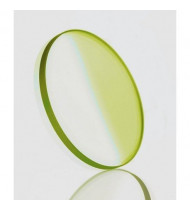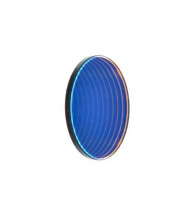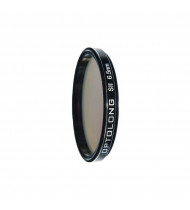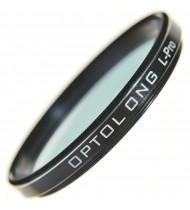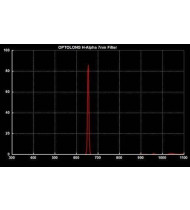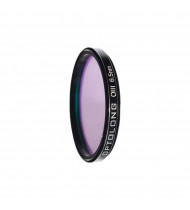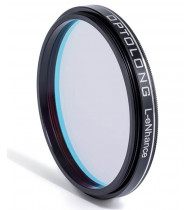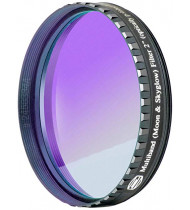

Optolong SII Filter 6.5nm 2" (50.8mm)
US$ 200.49Extra narrowband SII-CCD 6.5nm filter (Sulful II for CCD) is designed for nebula observation allowing 6.5nm bandwidth of light centered on a wavelength of 672nm through, and reducing the transmission of certain wavelengths of light, specifically those produced by artificial light including mercury vapor, and both high and low pressure sodium vapor lights and the unwanted natural light caused by neutral oxygen emission in our atmosphere (i.e. skyglow).
Optolong Kit L-RGB 1,25" (31.8mm)
US$ 191.58The LRGB filter kit is designed for maximum contrast and with extremely high gradients for a clear differentiation of light colors
Optolong L-eNhance Canon EOS Clip Filter
US$ 186.24EOS Clip version of the famous L-eNhance filter by Optolong
Optolong L-eNhance is a dual-band pass filter which has been designed for DSLR (digital SLR), color CMOS and monochrome CCD cameras. The convenience and cost effectiveness of this filter allows amateurs to image a rich selection of astronomical images, even in bright, heavily light-polluted areas. It effectively isolates the H-Alpha, H-Beta, and Oxygen III nebula emission lines and achieves a maximum transmission of up to 90%. The performance of this filter delivers superb images.Optolong L-eNhance Light Pollution Filter 2"
US$ 177.32L-eNhance 2" Optolong filter (M28x0.75) 50.8mm - Recommended for: shooting in double pass band (H-Alpha, OIII and H-Beta) with CMOS or CCD color cameras or DSLR
- The L-Pro CCD filter improves the contrast of deep-sky objects and reduces the sky background.
Optolong L-Pro Filter 2"
US$ 169.30The L-Pro CCD filter improves the contrast of deep-sky objects and reduces the sky background.
- blocks UV and IR (700 - 1100 nm)
- high transmission at passband
- improved color balance for DSLRs and One-Shot Color Astro Cameras, e.g. ASI Color Cameras cooled or uncooled by ZWO.
- high optical quality
- in 2" filter cell
- The L-Pro Nebula filter permits roughly 3x longer exposure times than without a filter and therefore improves contrast significantly.
Celestron Oxygen III Filter 50.8mm (2")
US$ 168.41- The 2" OIII narrowband filter isolates the two doubly-ionized oxygen lines (496 and 501 nm lines)
- Filter has ultra-hard, vacuum-deposited coating
- Eliminates un-natural colored halos surrounding bright stars
Optolong H-Alpha 7nm 36mm
US$ 155.93The H-ALPHA 7nm filter is the most popular narrow-band filter that allows a 7nm bandwidth centered on a 656nm wavelength.
Optolong OIII Filter 6,5nm 36mm
US$ 155.93Extra Narrowband OIII-CCD 6.5nm filter is designed for nebula observation allowing 6.5nm bandwidth of light centered on a wavelength of 500nm through, which corresponds to OIII emission lines, and reducing the transmission of certain wavelengths of light, specifically those produced by artificial light including mercury vapor, and both high and low pressure sodium vapor lights and the unwanted natural light caused by neutral oxygen emission in our atmosphere (i.e. skyglow).
Optolong SII Filter 6.5nm 36mm
US$ 155.93Extra narrowband SII-CCD 6.5nm filter (Sulful II for CCD) is designed for nebula observation allowing 6.5nm bandwidth of light centered on a wavelength of 672nm through, and reducing the transmission of certain wavelengths of light, specifically those produced by artificial light including mercury vapor, and both high and low pressure sodium vapor lights and the unwanted natural light caused by neutral oxygen emission in our atmosphere (i.e. skyglow).
Optolong SII Filter 6.5nm 1.25" (31.8mm)
US$ 150.59Extra narrowband SII-CCD 6.5nm filter (Sulful II for CCD) is designed for nebula observation allowing 6.5nm bandwidth of light centered on a wavelength of 672nm through, and reducing the transmission of certain wavelengths of light, specifically those produced by artificial light including mercury vapor, and both high and low pressure sodium vapor lights and the unwanted natural light caused by neutral oxygen emission in our atmosphere (i.e. skyglow).
Optolong L-Pro Filter 1.25"
US$ 147.02The L-Pro Astrophotography CCD filter is a filter for improving the contrast of deep-sky objects and dampening the sky background.
- blocks UV and IR (700 - 1100 nm)
- high transmission at passband
- improved color balance for DSLRs and One-Shot Color Astro Cameras, e.g. ASI Color Cameras cooled or uncooled by ZWO.
- high optical quality
- in 1.25" filter cell
- The L-Pro Nebula filter permits roughly 3x longer exposure times than without a filter and therefore improves contrast significantly.
Baader O-III Filter 2" (10nm) visual
US$ 147.02- ultra hard and bright O-III visual contrast for 6" and larger telescopes
- no visual color fringing, just pure O-III
- non-ageing sealed coating edges
Optolong H-Alpha 7nm 1.25" (31.8mm) v.2
US$ 138.11Bester H-alpha-Linienfilter für die Astrofotografie von Emissionsnebeln mit höchstem Kontrast und der Wiedergabe zartester Nebeldetails.
♦ schmalbandiger (<=7 nm) Linienfilter für wichtige Nebellinie
♦ bevorzugt für CDD-Kameras mit Full-Frame-Transfer-Technik
♦ 2 mm dick und somit homofokal mit vielen anderen Filtern von Optolong
♦ Interferenzfilter
♦ feinoptisch poliert
♦ mehrschichtig hartvergütet - reflexfrei und weitgehend kratzfestOptolong OIII Filter 6,5nm 1.25" (31.8mm)
US$ 132.77Extra Narrowband OIII-CCD 6.5nm filter is designed for nebula observation allowing 6.5nm bandwidth of light centered on a wavelength of 500nm through, which corresponds to OIII emission lines, and reducing the transmission of certain wavelengths of light, specifically those produced by artificial light including mercury vapor, and both high and low pressure sodium vapor lights and the unwanted natural light caused by neutral oxygen emission in our atmosphere (i.e. skyglow).
L-eNhance 1.25 "Optolong filter (M28x0.75) 31.8mm - Recommended for: shooting in double pass band (H-Alpha, OIII and H-Beta) with CMOS or CCD color cameras or DSLR
Baader H-alpha 35nm CCD Filter 2" (50.8mm)
US$ 129.20- Premium grade H-alpha interline chip CCD-filter for fast optical systems f/10 to f/2.8
- IR-blocked
- NO halos, NO reflections, NO ghosting
- non-ageing sealed coating edges
Baader Neodymium 2" (Moon & Skyglow)-Filter
US$ 129.20- The best visual and photographic filter for contrast enhancement for all telescopes, without loss of image brightness!
- The effect of the element neodymium as filter material is very impressive. When added to optical glass, it enhances contrast, enhances the red colour in the image (especially with Mars and Jupiter) and it darkens the spectral region which is particularly marked by street lamp light, which is the biggest contributor to the nightly "Skyglow".
- Planoptically polished and MC-coated – with IR-cut coatings!, without any loss of sharpness as a single filter in front of a binocular or be used for afocal projection with digital cameras (far from the focal point!)
- The IR spectral range is blocked making stars much sharper when used with dSLRs.

